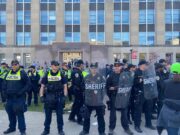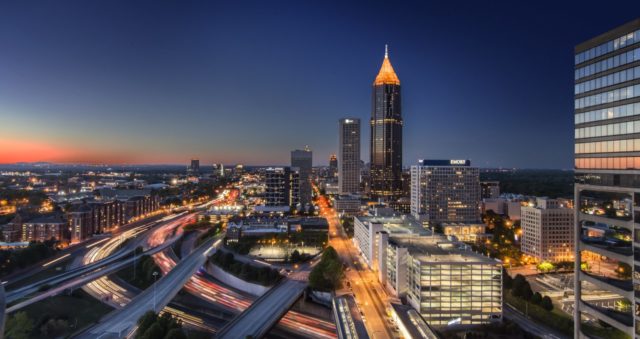(CNN) — A version of this story appeared in CNN’s Race Deconstructed newsletter. To get it in your inbox every week, sign up for free here.
Buckhead wants to cut out of the Black Mecca.
According to a September analysis by The Atlanta Journal-Constitution, about 54% of the residents surveyed “strongly or somewhat support” seceding from Georgia’s capital, ostensibly spurred by fears of recent spikes in crime across the city.
Racial demographics complicate the data. Well-to-do Buckhead is a majority-White neighborhood; Atlanta, majority Black. Some observers worry that cityhood for Buckhead could be devastating, removing access to revenue from a critical tax base and even deepening racial tensions.
The combustible, decades-long debate over Buckhead shines a light on a broader racial reality in the US.
“Today, you really have two kinds of racial residential segregation,” Stephen Menendian, the assistant director and director of research at UC Berkeley’s Othering and Belonging Institute and the lead author of a June report on racial residential segregation in the 21st century, told CNN. “Within large cities, you have racially identifiable neighborhoods and schools. You also have suburbs that are White and affluent, and then suburbs that are heavily non-White and much poorer.”
As Sheryll Cashin, a professor at the Georgetown University Law Center, explains it, the consequences of residential caste are vast.
“The successful have seceded from the struggling. Highly educated and affluent people tend to live in their own neighborhoods and support policies like exclusionary zoning and neighborhood school assignments that lock others out and concentrate advantage,” she writes in her essential new book, “White Space, Black Hood: Opportunity Hoarding and Segregation in the Age of Inequality.”
Here’s an overview of how the US got to this point — and how it might move forward:
Are there particular factors that contribute to residential caste?
Cashin presents three anti-Black processes that sustain residential caste. One is boundary maintenance, or practices and policies that keep Black people at a remove. Recall the secession fight over Buckhead, a patrician neighborhood that’s long played an important role in Atlanta’s history of race and space, as the Princeton University professor Kevin M. Kruse maps out in his 2007 book, “White Flight: Atlanta and the Making of Modern Conservatism.” Or think about the uneven impact that highway construction can have on marginalized groups. Of the people who would be displaced by a project to expand the West I-526 Lowcountry Corridor in South Carolina, 94% live in largely Black and brown communities.
Another process is opportunity hoarding, or overinvesting in some communities while disinvesting elsewhere. Cashin calls the former “gold standard” neighborhoods — neighborhoods of tremendous opportunity that are frequently subsidized by everyone else and that get the best of everything, from grocery stores to infrastructure to schools. In fact, schools are one of the best indicators of racial segregation. “If you really want to get a handle on this, go online, look at the schools in your community and look at the racial demographics of those schools. They’re often stark in any major metropolis unless there’s an integration plan,” Menendian said.
The third process is stereotype-driven surveillance. It’s easier to harden boundaries and isolate opportunity when the image of the “hood” is as devoid of dimension as it is. Former President Donald Trump was the most vulgar broadcaster of what Cashin refers to as “ghetto myths,” but others also have nourished these narratives.
What does this stereotyping look like?
Let’s revisit the Trump example. Remember when he crossed swords with Democratic Rep. Elijah Cummings — who represented Maryland’s majority-Black 7th Congressional District, which includes parts of Baltimore, where Cummings was born — over conditions at the US-Mexico border?
“Cumming (sic) District is a disgusting, rat and rodent infested mess. If he spent more time in Baltimore, maybe he could help clean up this very dangerous & filthy place,” Trump tweeted in 2019.
It was the precise sort of comment — repellent, clueless, made on Twitter — that was characteristic of the former President. In his rant, Trump didn’t only snap back at one of his innumerable critics. He conjured the mythos of the inner city, the Black ghetto. Disgusting. Dangerous. Filthy.
Other politicians have tossed around similar rhetoric. Here’s Rudy Giuliani, who, in the aftermath of the 2020 presidential election, made fact-free accusations of voter fraud against cities with significant Black populations: “Happens all the time in Philly. … And it’s allowed to happen because it’s a Democrat (sic), corrupt city, and has been for years. Many, many years. And they carried it out in places where they could get away from it.”
And here’s “law and order” booster Richard Nixon in 1967, in the thick of a years-long, nationwide wave of Black rebellion: “Today in the urban slums, the limits of responsible action are all but invisible.”
Even politicians on the other side of the aisle have sustained ghetto myths. After the killing of Freddie Gray, former President Barack Obama condemned the “thugs who tore up” Baltimore. “He was talking about vandals, but he was still participating in a very specific anti-Black idea,” Cashin told CNN. “Part of why it’s so challenging to pursue humane policies that can uplift people in high-poverty areas is because we apply a lens of presumed thug — instead of presumed citizen.”
Does residential segregation look the same today as it did a few decades ago?
It looks quite a bit different. Menendian said that about five or six decades ago, you could find the same pattern of segregation in almost every major US city: In big urban areas, Black families were circumscribed to a small number of neighborhoods that were often downwind of factories, near industrial areas, or close to various environmental contaminants. White families, on the other hand, lived in the same cities but in dramatically different neighborhoods.
Notably, this trend fits with Cashin’s notion of boundary maintenance.
“The main response (by localities and the federal government) to some six million Great Migrants escaping Jim Crow and going north and west was essentially to contain them in their own neighborhoods,” she said.
By the 1990s, residential patterns began to change. For one, between 1990 and 2000, large groups of people of color — fueled by greater income levels and less housing discrimination, among other things — started to move into the suburbs. But as the suburbs diversified, they also began to further fragment into inner-ring suburbs and wealthier outer-ring suburbs (or exurbs), which typically have newer infrastructure and better schools.
It’s still segregation — just in a different guise.
As the UC Berkeley report lays out in granular detail, “not only are most of our major metropolitan regions and cities highly segregated, but we find that nearly 81% American cities and metropolitan regions are more segregated today than they were in 1990, after several decades of federal policy applied to this problem.”
Is it possible to break up the boundaries of residential caste?
As you might imagine, concretizing aspirations for large-scale change won’t be easy or straightforward. But there’s hope to be had.
“Integrate and invest. We need to resurface the reality that racial segregation is really the core cause of racial inequality,” Menendian said in June. “You can’t zero out racial inequality in a highly segregated society.”
Cashin underscored that she’s inspired by the fact that the US has ascending, multiracial coalitions of people who say that Black Lives Matter.
“There are growing coalitions that can get to 51% in a mayoral race, in a city council race, in a debate about: Are we going to do our part to affirm and further fair housing? Are we going to pass a mandatory inclusionary zoning ordinance? Are we going to support racial equity, a neighborhood analysis that pays attention to how we spend money?” she said.
Baltimore has made headway in this regard. By ballot initiative, the city recently changed its charter and created a permanent fund to nurture racial equity in education, housing and the budget. The move allowed Baltimore to start repairing, and atoning for its treatment of, historically under-funded Black neighborhoods.
“I sense an authenticity,” Cashin added. “People seem to want something much better than a society that’s premised on separate and unequal, a society that’s premised on fear and the exclusion of the other.”
The-CNN-Wire
™ & © 2021 Cable News Network, Inc., a WarnerMedia Company. All rights reserved.




























